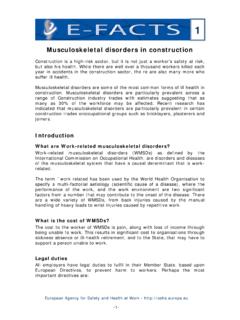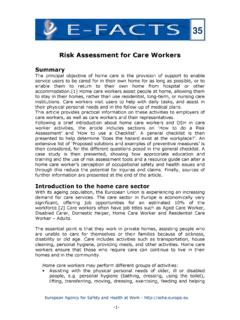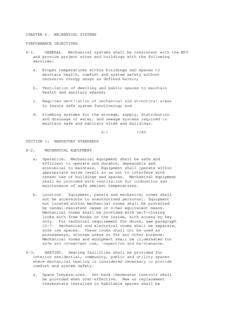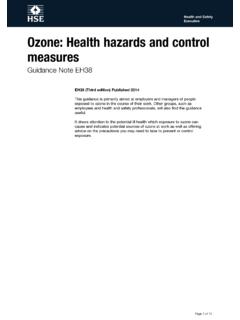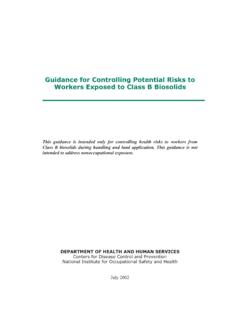Transcription of RISK ASSESSMENT FOR BIOLOGICAL AGENTS
1 53. RISK ASSESSMENT FOR BIOLOGICAL AGENTS . Summary BIOLOGICAL AGENTS are everywhere, and while they may be very beneficial for life they may also be dangerous. BIOLOGICAL AGENTS are relevant to many trades and occupations, and a sizeable portion of the working population faces the risk of exposure. Despite this, workers and employers tend to know little about the risk of exposure to BIOLOGICAL AGENTS . Risk ASSESSMENT for BIOLOGICAL AGENTS is challenging, for many reasons. First, because of the diversity of these AGENTS . In addition, occupational exposure limits (OELs) have not been set for many of them. Pathogenic micro- organisms may be hazardous at extremely low concentrations, and of course BIOLOGICAL AGENTS are not visible to the naked eye. Even if no BIOLOGICAL agent is detected, it is possible for micro-organisms to provoke a toxic or allergic effect via their metabolites (mycotoxins or their component endotoxins).
2 Unlike other dangerous substances, BIOLOGICAL AGENTS are able to reproduce. Under favourable conditions, a small number of micro-organisms may multiply in a very short time to create a considerable problem. Preventing BIOLOGICAL risks is mandatory by law according to Directive 2000/54/CE. Trades and occupations exposed to BIOLOGICAL AGENTS are well defined, and it is also known how workers are infected. The basic mechanism of infection is the transmission chain from the reservoir source of infection to the host (the worker). Prevention will concentrate on cutting one or several links in the transmission chain. Most of the time, basic personal hygiene measures and wearing personal protective equipment (PPE). provides sufficient protection against BIOLOGICAL AGENTS .
3 Risk ASSESSMENT will concentrate on identifying the hazards, assessing the risks and then controlling those risks. Following a brief introduction to BIOLOGICAL AGENTS and the hazards generated by these AGENTS , e-fact includes sections on How to do a Risk ASSESSMENT ' and How to use a Checklist'. A checklist is then presented to help identify the hazards potentially posed by BIOLOGICAL AGENTS . An extensive list of proposed solutions and examples of preventive measures' is then considered in the light of some of the questions raised in the general checklist. An example of risk ASSESSMENT relating to legionella is then presented. Finally, sources of further information are presented at the end of the e-fact. Introduction to BIOLOGICAL AGENTS BIOLOGICAL AGENTS are living organisms or products of living organisms.
4 They include viruses, bacteria and fungi and their metabolites, as well as parasitic worms and plants. They can enter the body by inhalation, by ingestion or by absorption through the skin, eyes, mucous membranes or wounds (bites from animals, needlestick injuries, etc.). If the living conditions are favourable viruses, bacteria and fungi can reproduce very rapidly in a very short time. In addition, some of them can be passed from one person to another. The European directive 2000/54/CE divides BIOLOGICAL hazards (pathogens) into four groups, based on the inherent hazard of the organism. (This classification refers only to the level of infection risk of the BIOLOGICAL agent concerned.). Group 1 Unlikely to cause human disease;. Group 2 Can cause human disease and might be a hazard to workers; unlikely to spread to the community; there is usually effective prophylaxis or treatment available.
5 Group 3 Can cause severe human disease and present a serious hazard to workers; it may present a risk of spreading to the community, but there is usually effective prophylaxis or treatment available;. Group 4 Causes severe human disease and is a serious hazard to workers; it may present a high risk of spreading to the community; there is usually no effective prophylaxis or treatment available. European Agency for Safety and health at Work (EU-OSHA) - 1. Risk ASSESSMENT for BIOLOGICAL AGENTS It should be noted that as the BIOLOGICAL AGENTS included in Group 1 are too numerous to specify, if an agent is not listed this does not mean that it automatically falls into Group 1. But BIOLOGICAL AGENTS are not only a risk because they are infectious and toxic they can also cause allergic reactions such as hypersensitivity pneumonitis, allergic rhinitis, some types of asthma and organic dust toxic syndrome (ODTS).
6 The sensitising effects of BIOLOGICAL AGENTS are not related to the risk groups. Sensitising effects are known for fungi, bacteria and few parasites. Normally they affect the respiratory system but a few affect the skin. In addition, some BIOLOGICAL AGENTS may have a carcinogenic effect after a chronic infection. This issue is a serious health at work matter and it overlaps with the public health sphere. Hazards generated by BIOLOGICAL AGENTS BIOLOGICAL AGENTS are necessary to life and have beneficial effects, although in some cases they may endanger human life. BIOLOGICAL risks have been around ever since living organisms appeared on earth, and they are to be found everywhere. BIOLOGICAL AGENTS may be used deliberately, but most of the time workers are exposed to them unintentionally.
7 This E-fact will deal with situations where workers are potentially exposed to BIOLOGICAL AGENTS as a result of their work and does not distinguish between intentional and unintentional exposures. Infection at the workplace can occur via different sources such as (Advisory committee on Dangerous Pathogens, 2003): blood and other body fluids;. human bodies, animal carcasses and raw meat;. human or animal waste products such as faeces and urine;. respiratory discharges such as coughs and sneezes;. skin contact. Allergic and toxic reactions can occur via: moulds or mould spores;. dust mites, feathers, animal hairs, pollen. Scientists, doctors and laboratory staff are aware of these risks but most employees and employers know little about them, not least because they are invisible.
8 This may explain why risk ASSESSMENT is difficult to undertake. Lack of adequate information on BIOLOGICAL risks and the inadequate provision of OSH training to workers can also inhibit effective risk ASSESSMENT . To determine where BIOLOGICAL risks are present one has to consider the activity taking place. If living or dead humans or animals, food, plants and wood, soil or water are present in the work environment, BIOLOGICAL risks must be assessed. Relevant activities include farming, the food industry, health care and social services, veterinary services, waste and wastewater management, and funeral services. Fishing, ceramic tile making, cotton and paper production, cork making and many other economic activities are also potentially at risk from BIOLOGICAL hazards.
9 Another way to pinpoint critical places is to consider the occupation. In addition to farmers, health care staff and food industry workers, many other occupations are affected, such as gardeners, sewage workers, prison warders, emergency services workers and even museum staff or people working on roofs littered with bird droppings. It is apparent that a sizeable percentage of the working population is potentially at risk. Technologies using BIOLOGICAL AGENTS in metal working shops are increasing the spectrum of at-risk trades, as is the use of high-pressure water generating aerosols. European Agency for Safety and health at Work (EU-OSHA) - 2. Risk ASSESSMENT for BIOLOGICAL AGENTS Some examples of workplaces with potential exposure to BIOLOGICAL AGENTS : 1. Food production plants 2.
10 Agriculture 3. Activities where there is contact with animals and/or products of animal origin (abattoirs). 4. health care, including isolation and post-mortem units 5. Refuse disposal plants (waste handling and sorting plants). 6. sewage purification installations Picture 1: health care workers are exposed to BIOLOGICAL AGENTS . Source: HVBG Germany Picture 2: Workers exposed to BIOLOGICAL AGENTS in a waste sorting plant. Source: Willer, BGF. European Agency for Safety and health at Work (EU-OSHA) - 3. Risk ASSESSMENT for BIOLOGICAL AGENTS Directive 2000/54/EC on the protection of workers from risks related to exposure to BIOLOGICAL AGENTS at work lays down particular minimum provisions in this area. According to this Directive the risk ASSESSMENT shall entail: a hazard identification, which consists in identifying the BIOLOGICAL AGENTS or their products likely to be present and the adverse effects that they have an inherent capacity to cause.


